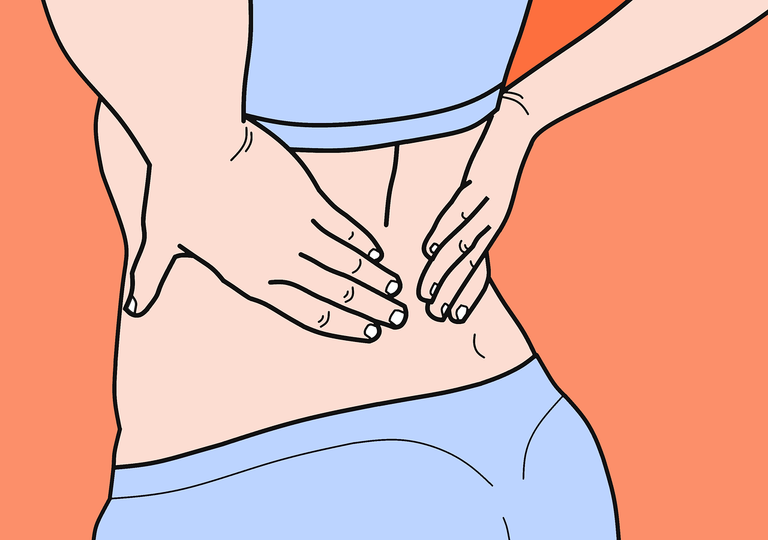My sister called me earlier this week to inform me about how the pain my Dad has been experiencing in his back has gotten worse, this back pain has existed for a while, and when he visited the hospital, the doctor said he was going to give him a massage and he was to pay a particular sum to get that done.
It was worrisome because the test result showed that it could be due to some bacterial infection, we were wondering where massage came in in the place of bacterial infection. To feel better, my Dad got the massage done but the pain still did not subside. I feel bad because if only I had the financial capacity to take him to a better hospital, this may not be happening.

flickr.com
I feel really scared because I want nothing to happen to that man, he has sacrificed so much and enjoyed nothing yet, so I decided to do my research, while we continue to get the help of professionals. I wanted to know what the possible causes are, and here are the results I got.
Lower back pain is one of the most common health problems experienced by older adults leading to pain and disability. It is said to affect any age group but is more common amongst adults from the age of 60 and older.
Low back pain is the single leading cause of disability worldwide according to WHO, in 2020 it affects 619 million people globally and based on estimation, the number of cases might increase to 843 million by 2050.
Lower back pain could be a dull or a sharp pain, it could also cause pain to radiate in other areas of the body, especially the legs. The presence of this pain may restrict movement, and affect the quality of life of the affected person. Problems may come with sleep, low mood, and distress. It could be acute lasting for less than 6 weeks, sub-acute lasting for 6-12 weeks, or chronic lasting for over 12 weeks.
People who have lower back pain may also experience spine-related leg pain, often described as a dull sensation or a sharp, electric shock feeling.

needpix.com
Lower back pain can generally be classified as specific or non-specific, according to WHO. Non-specific means that pain experience cannot be attached to any underlying disease, pathology, or tissue damage. The non-specific type is often the most common in most cases while specific lower back pain, on the other hand, is usually attached to an underlying disease like tissue damage, cancer or even affecting other organs like kidney or aortic aneurysm.
Prior work exposure: Occupational exposure when younger involving the act of lifting, bending, twisting, and stooping has been identified as a potential risk factor for lower back pain. A research carried out on 1500 individuals showed that previous occupational biochemical exposure for at least 10 years, could result in a case of lower back pain in retired adults. My Dad's job was an extremely strenuous one that had him bending, and walking over long distances when he was younger.
Gene: Genetic factors play a strong role in this happening, vulnerability to chronic pain development. Some people may develop chronic lower back pain as a result of their genetic makeup.
Demographic factors: Those with lower educational backgrounds, who smoke a lot are prone to lower back pain. It is believed that people who are more educated and have more access to funds have a better understanding of pain, better compliance with treatment, and a strong willingness to adopt a healthy lifestyle.
Psychological distress: Cases of anxiety or depression in older adults may result in a case of lower back pain.
Low health status: Adults whose health status ar not so good are more likely to experience severe lower back pain than others whose health is stronger.
Understanding that adults with lower back pain are more likely to suffer decreased morbidity and functional deterioration than younger people is important, so reporting them for fall prevention intervention is more important.
The treatment for a case of non-specific lower back pain includes;
- The advice to limit strain during physical work.
- Lifestyle changes that has to do more with healthy diet, good sleep habits, and physical activity.
- Psychological and social support to help manage pain and return to enjoyable activities.
- Physical therapies to help improve muscle strength and ability to move around.
Painkillers should not be the first line of treatment, medicines can be taken to reduce the symptoms of lower back pain. It is advisable that before medications are taken, a visit to the hospital should be seriously considered first especially in older adults.
I also learned that self-care is important when it comes to managing lower back pain, which can be achieved through;
- Sleeping well.
- Becoming physically active.
- Paying attention to mental well-being.
- Sleeping well.
- Making significant adjustments at the workplace.
Okay, I am a little more worried after knowing all this information and knowing it could get worse, we need to pay a visit to the hospital again, another one this time around. However, I am glad about the information I know too, some of the home remedies he needs to practice to help him feel relieved.
For Further Studies.
https://www.who.int/news-room/fact-sheets/detail/low-back-pain
https://www.medicalnewstoday.com/articles/322582#summary
https://www.ncbi.nlm.nih.gov/pmc/articles/PMC3772691/
https://www.ncbi.nlm.nih.gov/pmc/articles/PMC5395891/doe

Hi, I am Tobi, a writer, speaker, relationship blogger, and lover of good music. I love making friends and learning from people. If you want to hear me speak on relationships and general life issues, you can find my YouTube channel where you can watch any episode for free, please do not forget to subscribe, friends. I sincerely appreciate every love I get from here, Kindly do well to keep them coming.

